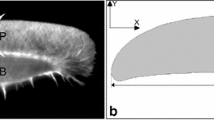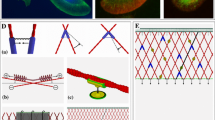Abstract
The network of actin filaments in the lamellipodium (LP) of stationary and migrating cells flows in a retrograde direction, from the membrane periphery toward the cell nucleus. We have theoretically studied this phenomenon in the circular stationary (fully spread) cells. Adopting a continuum view on the LP actin network, new closed-form solutions are provided for the actin-retrograde-flow (ARF) in a polar coordinate system. Due to discrepancy in the mechanical models of the actin network in the ARF regime, solutions are provided for both assumptions of solid and fluid behavior. Other involved phenomena, including polymerizing machine at the membrane periphery, cytosol drag, adhesion friction, and membrane tension, are also discussed to provide an overall quantitative view on this problem.



Similar content being viewed by others
References
Abraham, V. C., Krishnamurthi, V., Taylor, D. L., & Lanni, F. (1999). The actin-based nanomachine at the leading edge of migrating cells. Biophys. J., 77, 1721–1732.
Alexandrova, A. Y., Arnold, K., Schaub, S., Vasiliev, J. M., Meister, J.-J., Bershadsky, A. D., et al. (2008). Comparative dynamics of retrograde actin flow and focal adhesions: formation of nascent adhesions triggers transition from fast to slow flow. PLoS ONE, 3, e3234.
Babich, A., Li, S., O’Connor, R. S., Milone, M. C., Freedman, B. D., & Burkhardt, J. K. (2012). F-actin polymerization and retrograde flow drive sustained PLCγ1 signaling during T cell activation. J. Cell Biol., 197, 775–787.
Barocas, V. H., & Tranquillo, R. T. (1997). An anisotropic biphasic theory of tissue-equivalent mechanics: the interplay among cell traction, fibrillar network deformation, fibril alignment, and cell contact guidance. J. Biomech. Eng., 119, 137–145.
Betz, T., Koch, D., Lu, Y.-B., Franze, K., & Käs, J. A. (2011). Growth cones as soft and weak force generators. Proc. Natl. Acad. Sci. USA, 108, 13420–13425.
Campàs, O., Mahadevan, L., & Joanny, J.-F. (2012). Actin network growth under load. Biophys. J., 102, 1049–1058.
Craig, E. M., Van Goor, D., Forscher, P., & Mogilner, A. (2012). Membrane tension, myosin force, and actin turnover maintain actin treadmill in the nerve growth cone. Biophys. J., 102, 1503–1513.
Gardel, M. L., Sabass, B., Ji, L., Danuser, G., Schwarz, U. S., & Waterman, C. M. (2008). Traction stress in focal adhesions correlates biphasically with actin retrograde flow speed. J. Cell Biol., 183, 999–1005.
Gardel, M. L., Schneider, I. C., Aratyn-Schaus, Y., & Waterman, C. M. (2010). Mechanical integration of actin and adhesion dynamics in cell migration. Annu. Rev. Cell Dev. Biol., 26, 315–333.
George, U. Z., Stéphanou, A., & Madzvamuse, A. (2013). Mathematical modelling and numerical simulations of actin dynamics in the eukaryotic cell. J. Math. Biol., 66, 547–593.
Gholami, A., Wilhelm, J., & Frey, E. (2006). Entropic forces generated by grafted semiflexible polymers. Phys. Rev. E, 74, 1–21.
Gholami, A., Enculescu, M., & Falcke, M. (2012). Membrane waves driven by forces from actin filaments. New J. Phys., 14, 115002.
Henson, J. H., Cheung, D., Fried, C. A., Shuster, C. B., McClellan, M. K., Voss, M. K., et al. (2009). Structure and dynamics of an Arp2/3 complex-independent component of the lamellipodial actin network. Cell Motil. Cytoskelet., 66, 679–692.
Hotulainen, P., & Lappalainen, P. (2006). Stress fibers are generated by two distinct actin assembly mechanisms in motile cells. J. Cell Biol., 173, 383–394.
Ji, L., Lim, J., & Danuser, G. (2008). Fluctuations of intracellular forces during cell protrusion. Nat. Cell Biol., 10, 1393–1400.
Keren, K. (2011). Cell motility: the integrating role of the plasma membrane. Eur. Biophys. J., 40, 1013–1027.
Keren, K., Yam, P. T., Kinkhabwala, A., Mogilner, A., & Theriot, J. A. (2009). Intracellular fluid flow in rapidly moving cells. Nat. Cell Biol., 11, 1219–1224.
Keren, K., Yam, P. T., Kinkhabwala, A., Mogilner, A., & Theriot, J. A. (2009). Intracellular fluid flow in rapidly moving cells. Nat. Cell Biol., 11, 1219–1224.
Kruse, K., Joanny, J. F., Jülicher, F., & Prost, J. (2006). Contractility and retrograde flow in lamellipodium motion. Phys. Biol., 3, 130–137.
Kuusela, E., & Alt, W. (2009). Continuum model of cell adhesion and migration. J. Math. Biol., 58, 135–161.
Lai, M., Krempl, E., & Ruben, D. (2010). Introduction to continuum mechanics (4th ed.). Amsterdam: Elsevier.
Lauffenburger, D. A., & Horwitz, A. F. (1996). Cell migration: a physically integrated molecular process. Cell, 84, 359–369.
Mogilner, A., & Keren, K. (2009). The shape of motile cells. Curr. Biol., 19, R762–R771.
Mogilner, A., & Oster, G. (1996). Cell motility driven by actin polymerization. Biophys. J., 71, 3030–3045.
Mogilner, A., & Oster, G. (2003). Force generation by actin polymerization II: the elastic ratchet and tethered filaments. Biophys. J., 84, 1591–1605.
Pollard, T. D., & Borisy, G. G. (2003). Cellular motility driven by assembly and disassembly of actin filaments. Cell, 112, 453–465.
Ponti, A., Machacek, M., Gupton, S. L., Waterman-Storer, C. M., & Danuser, G. (2004). Two distinct actin networks drive the protrusion of migrating cells. Science, 305, 1782–1786.
Pujol, T., du Roure, O., Fermigier, M., & Heuvingh, J. (2012). Impact of branching on the elasticity of actin networks. Proc. Natl. Acad. Sci. USA, 109, 10364–10369.
Rice, R., & Barocas, V. (2003). A discrete-cell model of tissue-equivalent compaction. In W. Alt, M. Chaplain, M. Griebel, & J. Lenz (Eds.), Polymer and cell dynamics—multiscale modeling and numerical simulations (pp. 243–250). Basel: Birkhäuser.
Ridley, A. J., Schwartz, M. A., Burridge, K., Firtel, R. A., Ginsberg, M. H., Borisy, G., et al. (2003). Cell migration: integrating signals from front to back. Science, 302, 1704–1709.
Rotsch, C., Jacobson, K., & Radmacher, M. (1999). Dimensional and mechanical dynamics of active and stable edges in motile fibroblasts investigated by using atomic force microscopy. Proc. Natl. Acad. Sci. USA, 96, 921–926.
Rubinstein, B., Jacobson, K., & Mogilner, A. (2005). Multiscale two-dimensional modeling of a motile simple-shaped cell. Multiscale Model. Simul., 3, 413–439.
Rubinstein, B., Fournier, M. F., Jacobson, K., Verkhovsky, A. B., & Mogilner, A. (2009). Actin-myosin viscoelastic flow in the keratocyte lamellipod. Biophys. J., 97, 1853–1863.
Sabass, B., & Schwarz, U. S. (2010). Modeling cytoskeletal flow over adhesion sites: competition between stochastic bond dynamics and intracellular relaxation. J. Phys. Condens. Matter, 22, 194112.
Shao, D., Levine, H., & Rappel, W.-J. (2012). Coupling actin flow, adhesion, and morphology in a computational cell motility model. Proc. Natl. Acad. Sci. USA, 109, 6851–6856.
Shemesh, T., Verkhovsky, A. B., Svitkina, T. M., Bershadsky, A. D., & Kozlov, M. M. (2009). Role of focal adhesions and mechanical stresses in the formation and progression of the lamellum interface. Biophys. J., 97, 1254–1264.
Shemesh, T., Bershadsky, A. D., & Kozlov, M. M. (2012). Physical model for self-organization of actin cytoskeleton and adhesion complexes at the cell front. Biophys. J., 102, 1746–1756.
Taber, L. A., Shi, Y., Yang, L., & Bayly, P. V. (2011). A poroelastic model for cell crawling including mechanical coupling between cytoskeleton and actin polymerization. J. Mech. Mater. Struct., 6, 569–589.
Zimmermann, J., Brunner, C., Enculescu, M., Goegler, M., Ehrlicher, A., Käs, J., et al. (2012). Actin filament elasticity and retrograde flow shape the force–velocity relation of motile cells. Biophys. J., 102, 287–295.
Author information
Authors and Affiliations
Corresponding author
Electronic Supplementary Material
Below is the link to the electronic supplementary material.
Rights and permissions
About this article
Cite this article
Ghasemi V., A., Firoozabadi, B. & Saidi, M.S. Analytical Solutions of Actin-Retrograde-Flow in a Circular Stationary Cell: A Mechanical Point of View. Bull Math Biol 76, 744–760 (2014). https://doi.org/10.1007/s11538-014-9941-y
Received:
Accepted:
Published:
Issue Date:
DOI: https://doi.org/10.1007/s11538-014-9941-y




